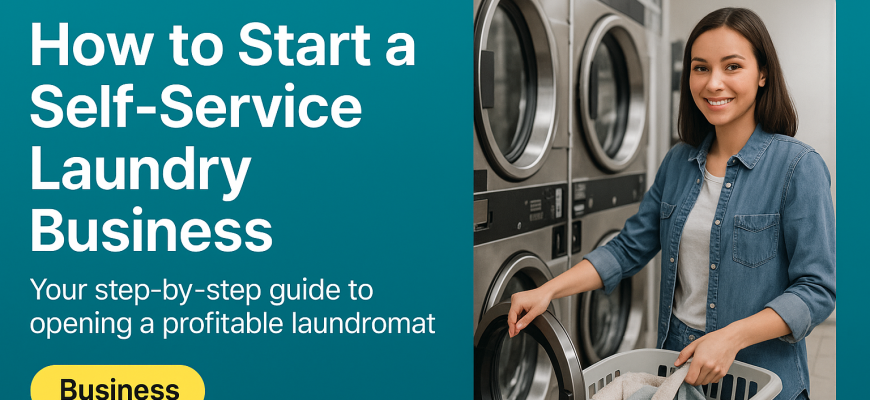Starting your own business is both exciting and challenging. If you’ve ever thought about launching a self-service laundry business (a laundromat), you’re looking at a venture with solid demand, flexible management, and great potential. As a business coach for women, I’ve seen many aspiring female entrepreneurs succeed in this space. This comprehensive guide will walk you through everything you need to know – from why a laundromat can be a smart choice, to how to actually get one up and running. Let’s get started on turning that laundromat dream into reality!
Why a Self-Service Laundry Business Is a Smart Choice
Steady Demand and Resilience: People always need clean clothes. The laundromat industry in the U.S. is worth over $5 billion and has remained consistent for years. It’s often called a recession-proof business – even in tough economic times, folks still have to do laundry. This means a more reliable, year-round income for you as an owner. In fact, laundromats have a very high success and survival rate (one source notes nearly double the average five-year survival rate for new businesses). That’s huge when you’re weighing where to invest your time and money.
High ROI Potential: Laundromats can offer strong profit margins. Some industry veterans report cash-on-cash returns of 20% up to even 100% in the best cases. While not every store will hit those numbers, a well-run laundromat can generate solid cash flow. Importantly, it’s mostly a cash/card business – customers pay upfront per use, so you won’t deal with invoicing or long accounts receivable delays. Money in the register (or card system) today is money in your pocket, which helps with steady cash flow.
Flexible Work-Life Balance: Owning a laundromat offers incredible flexibility in how you manage your time. Unlike a 9-to-5 job or some other businesses, you don’t have to be on-site all day, every day. You set the operating hours and can design a schedule that works for your life. Many laundromat owners treat it as a part-time involvement once things are running smoothly – you might only need to drop in a few times a week for collection, maintenance, or customer inquiries. You can even hire an attendant or manager to oversee daily operations, allowing you to step back when needed and enjoy a great work/life balance. This flexibility can be especially valuable for women entrepreneurs who may be balancing family or other commitments. One laundromat owner who was a single mom noted that the business gave her the freedom to arrange work around caring for her children – a huge advantage for her lifestyle.
Low Inventory and Staffing Needs: A self-service laundry is simpler than many retail businesses. You’re not managing a complex inventory of perishable goods or a large team of employees. Beyond the machines and supplies like detergent or dryer sheets, there’s little inventory to stock. Labor costs are relatively low too – many laundromats run with no full-time staff on-site or just one attendant, especially if you stick to pure self-service. This keeps overhead costs down and management simpler. (Of course, you might choose to add services that require staff, but that’s up to you and your business model – more on that later.)
Community Impact and Stability: Beyond the financial angles, a laundromat is a vital community resource. Think of single parents, students, elderly folks, or apartment dwellers who don’t have in-home laundry – you’ll be providing an essential service for them. Many women entrepreneurs love knowing their business makes a difference in daily lives. Plus, once customers find a laundromat they like, they tend to become loyal weekly visitors. This kind of repeat customer base builds stability into your revenue. Essentially, you have the chance to create a local hub that people rely on, which is both financially and personally rewarding.
High Flexibility in Growth: There’s plenty of room to get creative and grow. The laundry industry has a reputation for being a bit old-school in places, which means you can modernize and differentiate your laundromat (think apps for payments or pickup services) and gain an edge. Successful owners often expand to multiple locations once they get the hang of it. Owning one laundromat can turn into owning a chain, if that’s a goal for you – and many women have scaled in this industry by reinvesting profits or acquiring existing laundromats over time.
In short, a self-service laundry business offers a blend of practical benefits (steady demand, good ROI, manageable operations) and lifestyle perks (flexibility, community connection) that make it an attractive choice for women looking to become their own boss.
Initial Considerations: Know Your Market and Location
Before diving into the nitty-gritty steps, it’s important to do some homework on your market. A laundromat’s success is highly dependent on where it is and who it serves. Here are the key upfront considerations:
-
Target Market: Think about who will use your laundromat. Common customer groups include apartment renters (especially where units don’t have washers/dryers), college students, military families, tourists (if near hotels or hostels), and busy professionals who use wash-and-fold services. Each group has different needs. For example, college students want affordability and maybe late hours, whereas busy professionals might value extra services like drop-off laundry. Understanding your primary audience will help shape decisions on services, hours, and amenities. Do some informal surveying or research – what are the laundry habits in your community? Are there unmet needs, like no 24-hour laundromat in an area that could use one? The better you know your future customers, the better you can tailor your business to them.
-
Location: In the laundromat game, location can make or break you. Look for areas with a high population density and plenty of potential users. Urban areas, or towns with lots of multi-family housing, often have the most demand. Foot traffic and visibility are crucial too – a spot on a busy street or near other popular stores can attract walk-ins and increase awareness. Also consider parking and accessibility; customers will be hauling heavy bags of clothes, so convenient parking or at least easy drop-off access is a big plus. Safety is another factor – a well-lit, safe neighborhood will encourage customers (especially those washing clothes at odd hours) to choose your laundromat. Tip: Spend time in the area at different times of day to observe activity levels and feel out whether it’s the kind of place your target customers would feel comfortable.
-
Competition Analysis: Scout out the competition. Are there existing laundromats nearby? Visit them! Note their prices, the condition of their equipment, the services they offer (self-service only, or do they have wash-and-fold, dry cleaning, etc.?). Also observe how busy they are at various times. The goal isn’t necessarily to avoid any competition (some areas can support multiple laundromats), but to identify gaps in the market and figure out how you can differentiate. Maybe all the other places are closed by 9 PM – you could be the only late-night option. Or perhaps none of them offer pickup/delivery or have outdated machines – an opportunity for you to stand out. Thoroughly investigating other laundromats in the area will give you insight into what customers might not be getting and what you could do better. If the market looks saturated (lots of laundromats, not enough population), you might reconsider your location or niche. If it looks under-served, that’s a green light.
-
Local Demographics and Trends: It’s also useful to look at broader data. Check census or city data for things like how many renters are in the area, average household incomes, and even any growth trends. A neighborhood with many low-income families or college students might have higher laundromat usage (since higher-income households often have in-unit laundry). Also, is the area growing (new apartments coming up, etc.) or shrinking? All of this helps in forecasting demand.
-
Regulations or Restrictions: Some cities have specific zoning laws or permit limits for laundromats. It’s worth checking early if there are any local quirks – for example, a town that requires a special permit to open a laundromat, or a limit on water usage in certain districts. You don’t need all the details yet (we’ll cover licenses soon), but keep your antenna up for anything that could affect where you open or how you operate (like mandated closing times, etc., in certain zones).
By taking the time to understand your market and location up front, you’ll set a strong foundation for everything else. Now, with these considerations in mind, let’s move on to the step-by-step process of actually starting your laundry business!
Step-by-Step Guide: Launching Your Laundry Business
Ready to roll up your sleeves? Below is a step-by-step roadmap for turning your laundromat idea into a thriving reality. We’ll go through each major step – from planning to opening day – blending practical how-tos with a bit of encouragement along the way.
-
Research and Validate Your Idea – Start with thorough market research to validate that your self-service laundry concept makes sense in the area you’ve chosen. This means analyzing local demographics, mapping out competitors, and confirming there’s sufficient demand (we talked about this in “Initial Considerations” and now you’ll formalize it). Gather data on how many potential customers are nearby – e.g. high renter population or student population is a good sign. Identify what customers in your area value most: is it 24/7 access, very low price, super clean facility, extra services? Also research the laundromat industry basics: average costs, typical profit margins, etc. The Coin Laundry Association and small business sites can be helpful resources. Validate means critically ask: “Given what I see, can my business succeed here? What will make it unique or better?” It’s okay if you discover you need to tweak your original idea – that’s what this early stage is for. Better to adapt now than after investing money. By the end of this step, you should have a clear picture of your target market, an understanding of your competition, and confidence that there’s a niche for your laundromat in the community.
-
Write a Solid Business Plan – Next, put your vision on paper in a business plan. This is your roadmap and will be crucial if you seek funding. Don’t worry, it doesn’t have to be a literary masterpiece – it just needs to cover the essentials of how your business will operate and make money. Key elements to include are: an executive summary (a one-page overview of your plan), a description of your company and mission (e.g. “a women-owned laundromat serving X community with convenient, eco-friendly laundry services”), a market analysis (summarize your research on customer base and competition), an outline of your services (self-service laundry and any add-ons like wash-and-fold, dry cleaning drop-off, vending machines, etc.), and a basic marketing strategy (how you’ll attract customers and keep them). Also crucial are the financial projections – estimate your startup costs, operating costs, and expected revenues for at least the first year or two. How many daily customers at what price do you need to break even? Include how much funding you have/need and how it will be used (for equipment, lease, renovations, etc.). Writing this plan may seem daunting, but it’s incredibly clarifying. It forces you to answer tough questions on paper. And remember, a plan can evolve – you’re not married to every assumption, but you need a starting blueprint. This document will also come in handy to show potential lenders or partners that you’ve done your homework.
-
Handle Licensing and Legal Requirements – Time to tackle the paperwork side. First, choose a business structure and register your business name. Many laundromat owners form an LLC for liability protection (so your personal assets are safer in case of lawsuits or debts), but some start as sole proprietors – do what fits your situation. Next, obtain the necessary licenses and permits to legally operate. Typically, you will need a general business license from your city or county. Laundromats also deal with heavy water usage, so you may need permits related to water and sewer or waste water disposal. If you’ll be renovating a space, building permits might be required. You’ll likely need to pass a health and safety inspection (ensuring things like proper drainage, electrical wiring, and maybe fire safety protocols are in order). Don’t forget a sales tax permit if your state requires charging tax on laundromat services or if you plan to sell any retail products like detergent. Requirements vary widely by location, so check your city’s business website or consult with a local small business attorney to make sure you cover all bases. Additionally, look into insurance – you’ll want policies for liability (in case a customer slips on a wet floor or claims a machine ruined their clothes) and property insurance for your equipment. Getting your legal ducks in a row might not be glamorous, but it’s absolutely necessary to avoid costly troubles down the road. Take it step by step: register your business, then tackle each required permit. Many local governments have small business offices that can guide you through the process, so you’re not alone!
-
Secure Funding for Your Venture – Starting a laundromat does require a significant upfront investment. How much exactly? It can range widely – anywhere from around $50,000 to $500,000 or more to open a brand-new laundromat. Costs depend on your location, the number and types of machines, renovations needed, and whether you’re buying new equipment or used. Don’t let the big numbers scare you; instead, focus on how to finance the business smartly. If you have savings to cover it, great – but many entrepreneurs will seek a small business loan or other funding. Investigate SBA loans (Small Business Administration) which often have favorable terms for new businesses. A traditional bank loan is another route, especially if you have a solid business plan and good credit. Some laundromat equipment manufacturers or distributors offer financing programs specifically for equipment purchases – essentially a loan or lease that lets you pay off machines over time. You could also look for investors or even consider bringing on a business partner to share startup costs (just be sure to clearly outline roles and profit shares in that case). Another funding option: buy an existing laundromat instead of starting from scratch. Sometimes you can find a local laundromat for sale; acquiring it might cost less than new machines plus build-out, and it may come with an existing customer base. Just be sure to do due diligence on its financials and condition. However you proceed, be realistic with your budget. Account for all the initial expenses – machine purchases, deposit on a lease or property, plumbing and electrical work, interior renovations (flooring, paint, seating), signage, initial supply stock, and working capital to cover a few months of bills until revenue grows. It’s better to secure a bit more funding than you think you need, so you’re not caught short. Many women feel intimidated by the funding process (we sometimes hesitate to ask for big loans or negotiate), but remember: you deserve to invest in your dream. With a solid plan in hand, walk into that bank or lender meeting with confidence. You’re not asking for a favor; you’re presenting an opportunity.
-
Scout and Select the Right Location – Now that you have financing in motion, zero in on the location for your laundromat. Hopefully your earlier research identified some target neighborhoods. Now you’ll get into the specifics of finding a venue. Some key tips: focus on high-demand areas – places with lots of renters, apartment complexes, or students, and not too many competitors around. Look for a spot that has good visibility and accessibility. For example, a corner unit on a busy street or a storefront in a shopping strip can be ideal, because people can easily see it and get to it. Check that there’s ample parking or at least a safe drop-off zone; carrying laundry baskets for blocks is no fun, so convenience matters. Pay attention to the infrastructure: the space should be zoned for commercial use and able to handle the utility needs of a laundromat (big electrical supply, water inlet and drainage, ventilation for dryers, etc.). If it’s an empty shell, factor in the cost of installing all those connections. If it’s a previously operating laundromat location, that can save a ton on setup costs because the hookups might already be there. Also, negotiate wisely on your lease – a long-term lease can lock in your location, but make sure you include clauses that protect you (like options to renew, or escape clauses if certain conditions aren’t met by the landlord). Don’t rush this step. Visit at various times to gauge traffic. Imagine yourself as a customer – would you go out of your way to do laundry there? Once you find a promising spot, you might also check the neighborhood’s growth prospects (a new apartment building opening nearby can mean a wave of customers in a year!). If you’re unsure, consult a commercial real estate agent who has experience with small retail or laundromats. They can help with the fine print and negotiations. Remember, location is one of the biggest determinants of your laundromat’s success, so choose carefully.
-
Equip Your Laundromat with the Right Machines – The heart of your self-service laundry business is, of course, the equipment. It’s time to decide what kind of washers and dryers you need and acquire them. Key considerations include capacity (mix of small and large machines to handle different load sizes) and quantity. You don’t want customers to be waiting too long for a free machine during peak times. A common guideline is to have at least one machine for each customer you expect at your busiest hour. For instance, if you anticipate 10 users at once on a Saturday morning, aim for ~10 washers and a similar number of dryers. Next, decide on new vs. used machines. New machines come with warranties and are usually more energy-efficient (saving on water and electricity costs) and less prone to breakdowns. They might also have modern features like card readers or app connectivity. The downside is cost – new commercial washers/dryers are expensive. Used machines are cheaper upfront, which can be a lifesaver if you’re on a tight budget, but consider that they may have higher maintenance needs and shorter remaining lifespan. A mix could be an option (e.g. new washers for the high-capacity units and used for smaller ones). Also, decide on the payment system: traditional coin-operated machines, card-based systems, or app-based payments. Many newer laundromats offer cards or mobile app payments, which customers appreciate (no one likes lugging a bag of quarters), and these systems can also simplify your accounting. There’s an initial cost to set up cashless systems, but it can pay off in convenience. Don’t forget ancillary equipment: a change machine (if using coins), a soap vending machine, laundry carts, seating, folding tables, and maybe security cameras. Shop around with different suppliers – and negotiate. Often, equipment distributors will give discounts or flexible financing if you’re buying a whole store package. Also plan for ongoing maintenance: establish a relationship with a reliable technician or service company. Machines will need regular servicing to stay in top shape, and having support lined up means less downtime when something needs fixing. In summary, invest as wisely as you can in your equipment – it’s the backbone of your business and worth getting right.
-
Plan Your Operations (and Hire if Needed) – With location and machines set, it’s time to plan out how you will run the business day-to-day. This includes setting your hours of operation (will you be 24/7? 6 AM to 10 PM? Think about customer needs and your own capacity to supervise), your pricing (check competitors’ prices and decide if you’ll match or differentiate; you might charge by the load or by machine time, e.g. $4 per wash on a large machine, etc.), and your general policies (e.g. last wash time of the day, any time limits on machine use, how you’ll handle unclaimed clothes or machine misuse). Write down standard operating procedures for routine tasks: opening/closing procedures, cleaning schedules, money collection, etc. Even if you’re initially doing everything yourself, having these documented will help when you eventually delegate.
Hiring: One big question – will you hire staff or run the laundromat un-attended? Many self-service laundries operate with no attendant on-site most of the time. If you go this route, you as the owner will likely handle daily tasks (or do them on visits): cleaning the store, emptying coin boxes or refilling the change machine, routine maintenance checks, etc. The benefit is you save on payroll costs. However, for better customer service and security, some owners hire a part-time or full-time laundromat attendant. An attendant can keep the place tidy, assist customers who have issues or questions, and deter vandalism or theft. It’s especially worth considering if you plan to offer wash-and-fold services or want someone to handle drop-off orders. You might start unstaffed and later add an employee as finances allow, or start with an attendant during peak hours only. If you do hire, focus on someone trustworthy and friendly, since they’ll be the face of your business when you’re not around. Train them on how you want things run – customer service expectations, how to do minor fixes (like resetting a machine), safety procedures, etc. Whether or not you have staff on-site, also arrange for professional services like a cleaning crew (if not the attendant), trash removal, and a handyman/plumber contact for urgent repairs.
Systems and Technology: Part of operations planning is deciding on systems that make your life easier. For example, will you use any software to manage income/expenses or an app to remotely monitor machines? There are modern laundromat management apps that let you see machine usage and even alert you if a machine goes down. Some high-tech setups even allow customers to see machine availability online. While these are optional, leveraging technology can reduce how often you need to physically be in the store and improve service for customers – a win-win if budget permits. At minimum, have a good system for tracking your finances (even if it’s a simple Excel sheet or accounting software) and for customer feedback (like a comment box or an email/phone contact clearly posted).
Grand Opening Prep: As you finalize operations, start planning your opening day! Think about a soft opening first (a quiet launch to test everything works) followed by a grand opening event. For the grand opening, you can advertise special promotions (like one free dry per customer, or free coffee and donuts at the event). This is where your marketing plan comes into play: spread the word in the neighborhood that a new laundromat is opening. Use flyers, local Facebook groups, or community boards to announce your launch. Perhaps do a ribbon-cutting with a local community leader to get some buzz. The goal is to let everyone know there’s a new, welcoming laundry facility in town. We’ll cover more on marketing and customer loyalty in the next section, which is key to long-term operations.
Each step might feel like a lot, but take them one at a time. Every successful laundromat owner started with that first step of research and then kept going. Keep your vision in mind – a clean, bustling laundromat with happy customers – and work through these steps methodically. You’ve got this!
Tips for Long-Term Success and Building Customer Loyalty
Once your laundromat is up and running, the focus shifts to operating it successfully for the long haul. You want happy customers who keep coming back every week (and tell their friends!). Building that loyalty and maintaining a thriving business requires ongoing effort. Here are some top tips to ensure your laundromat remains the go-to spot and continues growing:
-
Keep It Clean, Safe, and Welcoming: This might be the number one rule of laundromat success. Customers spend a chunk of time in your space waiting for their laundry – a clean, comfortable environment will make them choose your location over others. Floor to ceiling cleanliness is key: regularly mop up spills, wipe down machines, clean lint traps, and keep trash cans emptied. Ensure ample lighting inside and out (a well-lit store also improves safety). Maintain working air conditioning or heat so it’s comfortable year-round. If you have TVs, set them to low, pleasant volume (and perhaps on channels that are generally agreeable). A fresh coat of paint and some cheerful signage can also make a difference in vibe. For safety, consider cameras and a clear code of conduct posted (like no loitering, unattended children, etc.). When people feel safe and at ease, they’ll gladly return. A family-friendly atmosphere – maybe a small kids’ play area or just some magazines and a couple of chairs – can go a long way in encouraging repeat visits.
-
Maintain Your Machines Religiously: Few things lose customer trust faster than constantly broken machines. Stay on top of maintenance so that nearly all your washers and dryers are operational at any given time. Develop a routine to inspect machines daily or weekly. Promptly put an “Out of Order” sign on any faulty machine and fix it as soon as possible. If a customer loses money in a machine or has a complaint, handle it kindly and, whenever reasonable, offer to compensate (like a free wash or refund). This kind of responsive customer service makes people feel valued. Also, rotating in newer equipment over the years will keep your store efficient and reliable. Customers notice when you upgrade to better machines! It tells them you care about quality. Clean machines inside and out (yes, wipe the drums and lids regularly). Reliable, clean equipment = happy customers = loyalty.
-
Offer Multiple Payment Options: In today’s world, flexibility in payment is a big perk. If you can, provide more than just coin-operated machines. Many modern laundromats have a loyalty card or app system where customers load money onto a card or app and use that to start machines. Others accept credit/debit cards or mobile payments directly at the machine. Why does this matter? Convenience! Not everyone carries quarters, and some people will choose a laundromat simply because they can pay with their phone or a stored-value card. As a bonus, card systems often let you implement loyalty rewards easily (e.g., every $10 spent gives a bonus $1 credit). If you do stick with coins, ensure your change machine is always working and consider also selling rolls of quarters for convenience. The easier you make it for customers to pay and do laundry, the more they’ll appreciate and return to your business.
-
Provide Perks and Loyalty Rewards: Little extras can delight customers and build loyalty. Think about offering loyalty discounts or programs – for example, a punch card where after 10 washes the 11th is free, or a monthly membership that gives a small discount after a certain number of loads. You could have a “Customer Appreciation Day” with discounted drying or free detergent packets. Some laundromats create a comfortable waiting area with free Wi-Fi, coffee, or vending machines for snacks/drinks. These amenities keep people happy (and even bring in a bit of extra income in the case of vending). Another idea: have a TV or bulletin board highlighting community events or even spotlighting a “customer of the month.” Such personal touches create a friendly community feeling. Be creative – what would you enjoy if you were spending 2 hours doing laundry? Even playing pleasant background music can improve the atmosphere. When customers feel they get a little extra value or enjoyment at your place, they’ll be loyal and might even do nice things like leave positive reviews online.
-
Engage with Your Community and Customers: Don’t be a passive owner – actively engage with your customer base. Simple interactions go a long way: greet people when you’re on-site, ask if everything’s working for them, and thank them for coming. If you’re not often on-site, leave a comment box or a clearly posted email/number for feedback and respond promptly to any issues. Host small events or drives – for example, a “Free Laundry for Volunteers” night where people who volunteer locally get free washes, or partner with a local charity for a holiday coat-washing drive. These not only do good, but also spread positive word of mouth about your laundromat. Social media can help too: create a Facebook or Instagram page for your laundromat. Post updates like new services (“We just installed brand new high-capacity dryers!”) or fun posts (“Happy Mother’s Day to all the hardworking moms – enjoy a free dryer sheet on the house this week!”). Engaging online lets you build a community beyond just transactions. Encourage satisfied customers to leave reviews on Google or Yelp – great reviews are gold for attracting new folks. Remember: a laundromat can actually become a bit of a social spot for the neighborhood. If you foster that sense of community, customers will feel a personal connection to your business.
-
Keep Learning and Adapting: The business environment can change – maybe a new competitor comes to town, or customers start asking for a wash-and-fold service you didn’t originally plan on. Stay open to adapting. Continue to read industry blogs, attend local business workshops, or join entrepreneur groups (there are many groups for women business owners where you can get fresh ideas and support). Perhaps technology advances and there’s a new app that can streamline your operations – don’t be afraid to embrace improvements. Also, track your business performance regularly: which days/times are busiest, what services or vending items sell well, etc. Use that info to optimize (like adjusting hours or running promotions during slow times). By keeping a mindset of continuous improvement, you’ll ensure your laundromat doesn’t get stagnant. Long-term success isn’t about doing one thing right and then coasting; it’s about consistently delivering quality and responding to your customers’ needs. The good news is, if you do that, you’ll develop a base of loyal customers and a strong reputation that will keep your business thriving for years to come.
In essence, treat your customers well and take pride in your laundromat. The more you put into maintaining and enhancing the customer experience, the more you’ll get out of it in loyalty and positive business growth. Many laundromat owners find that over time, their customers become like a community – some even on a first-name basis. That’s a great sign of a loyal customer base, and it all stems from the tips above: cleanliness, service, convenience, and care.
You’ve Got This!
Starting a self-service laundry business as a female entrepreneur is absolutely achievable. Yes, it’s a lot of work – from planning and permits to lugging machines and managing finances – but step by step, you can and will make it happen. Remember, every successful laundromat owner had a Day 1 when they felt nervous about opening the doors. It’s normal to feel that mix of excitement and anxiety. The key is to trust your preparation, stay adaptable, and keep your end goal in sight.
As Alex Rivers, a coach who has seen many women go from dreaming to doing, I want to remind you of your capability and resilience. Think about it: women manage households, careers, education, and so much more every day – those same skills (multitasking, budgeting, nurturing relationships, problem-solving) are going to be your superpowers in running a business. Whenever you hit a bump – and there will be bumps – take a breath and recall how far you’ve already come. You wrote a business plan, secured funding, navigated red tape, set up a whole store! That’s incredible.
If doubt ever creeps in, remember why you started. Maybe it’s for financial independence, to create a flexible lifestyle, to provide a needed service, or to be a role model for your family. Whatever your motivation, hold it close and let it drive you forward. There’s a quote I love: “She believed she could, so she did.” You are the “she” in that quote – believe you can, and you will do it.
Finally, know that you’re not alone. There’s a growing community of women entrepreneurs in every industry – including laundromats – who are cheering you on. Don’t hesitate to reach out, ask for advice, or just share your journey. Your story might inspire another woman to take the leap next.
One load at a time, one day at a time, you are building something amazing. Here’s to your successful laundromat business and the beginning of a wonderful entrepreneurial journey. I can’t wait to see what you accomplish – and I’m rooting for you all the way!









